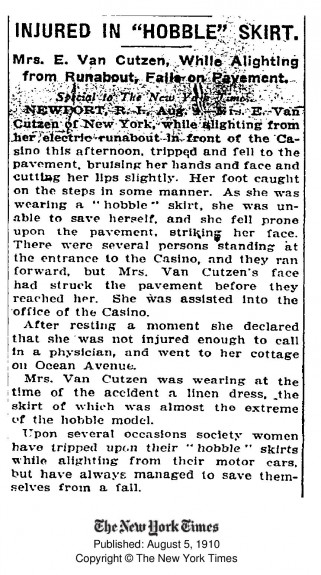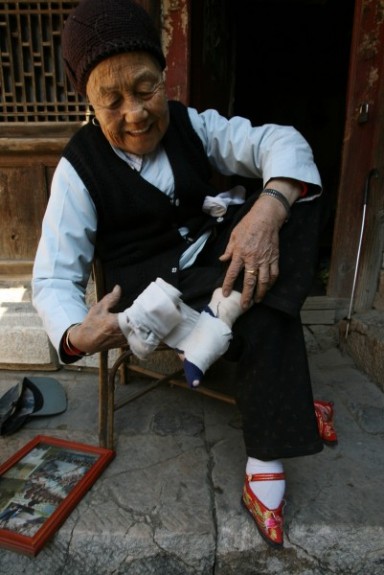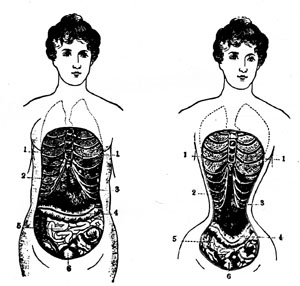The Perils of Wearing Clothes
From toxins in textile dyes to torturous corsets, beauty has a long history of coming at a high cost
![]()
Last month, Chinese school uniforms made the news. Studies had shown that possibly as many as 25,000 children in Shanghai, China, were wearing mandated uniforms that were essentially poisoning them. The fabric contained toxic aromatic amines, thought to be carcinogens and found in plastics, dyes and pesticides. Ingesting, inhaling or absorbing the chemicals is considered hazardous and some countries have banned them. Students were told to stop wearing the outfits made by Shanghai Ouxia Clothing Company until a complete investigation had taken place.
Horrifying, but not particularly surprising, considering how much China appears in the headlines for tainted products, the incident recalled a moment this past November when big, fast fashion chains were in the news for selling toxic clothes. Greenpeace published a report called Toxic Threads: The Big Fashion Stitch-Up, in which it uncovered how retailers including Zara, H & M and Nike had been incorporating harmful dyes into fabrics. More specifically:
A total of 141 items of clothing were purchased in April 2012 in 29 countries and regions worldwide from authorised retailers. The chemicals found included high levels of toxic phthalates in four of the garments, and cancer-causing amines from the use of certain azo dyes in two garments. NPEs were found in 89 garments (just under two thirds of those tested), showing little difference from the results of the previous investigation into the presence of these substances in sports clothing that was conducted in 2011. In addition, the presence of many other different types of potentially hazardous industrial chemicals was discovered across a number of the products tested.
According to the Huffington Post, just over a week after Greenpeace released the report, the international clothing chain Zara, committed to changing its ways. It will ”eliminate all discharge of hazardous chemicals” by 2020, the company said.
So how far have we really come from the time when ancient Egyptians used copper and lead in their eye makeup? In the 15th to 17th centuries, Romans used variations of lead and mercury to lighten their skin. When “Irish beauty Marie Gunning (a k a the Countess of Coventry) died in 1760, the press called her a ‘victim of cosmetics.’ ”
Style has trumped safety and comfort for centuries. Even though we now know these chemicals and dyes are bad for us, they keep creeping into our clothes and makeup. Sometimes we make decisions about what to wear based on what we think looks good, and in doing so, we do more damage to ourselves than we knew was possible.
For starters, take women’s shoes. High heels may make our legs look slim and elegant, but they are also known to cause ankle and heel pain, plantar fasciitis, painful swelling of the bottom of the foot, bunions and corns. Thick wooden wedges, five-inch stilettos and the heel-less Lady Gaga variety change our posture and how we arch our posteriors.
This performance offers a stark commentary on the subject, with the model assuming egretlike movements in order to walk in a very nontraditional pair of heels.
Historically speaking, one of the best-known examples of harmful body modification is foot binding. The Chinese practice kept a woman’s feet “dainty” and “lady-like” by tightly wrapping them when she was a child to prevent natural growth. The painful process was done to secure her role in the upper echelons of society.
By grossly deforming and disabling their feet and wearing tiny, delicate shoes, women would be more attractive to their mate, they were told, and would not be expected to work. Thankfully the practice was banned in 1912 (although people continued to bind in secret). On occasion, it’s still possible to encounter a woman from an older generation in China hobbling around on bound feet.

Speaking of hobbling, how about the hobble skirt? This form of restrictive, perilous garment was popularized in the 1910s and is generally attributed to French fashion designer Paul Poiret. Skirts were long and full, and they narrowed at the hem, or even at the calf, to provide a ballooning effect.
But there’s another version of the skirt’s origin that suggests a practical side to the style. The story goes that when Mrs. Hart Berg went on a flight with the Wright brothers, the first woman to do so, she tied a rope around the bottom of her long skirt to keep it from billowing in the air. Soon the Wright brothers’ sister, Katherine Wright, did the same. The trend took off and women attempted to wear these hazardous skirts to perform everyday tasks without falling flat on their faces, as depicted in numerous news stories from the time. The style lost its luster with the advent of the car, which certainly makes sense. Imagine trying to climb into a Ford Model T with the equivalent of an unforgiving elastic band wrapped around your calves.
Finally, no overview of clothing hazards would be complete without acknowledging the corset. For hundreds of years, the corset has been worn to mask or accentuate the natural curves of a woman’s, or man’s, body. With whalebone or metal boning and tight-lacing, the body-binders prompted medical professionals, especially in the 1800s, to try to bring an end to their use, explaining that they hindered muscle development, mobility and, well, the ability to breathe. The doctors were on to something, but, as was the case with bound feet, many women weren’t ready to give up the body-shaper because, they, or society, preferred the corseted shape over their natural one.
What are examples of dangerous or precarious clothes, shoes or underwear you’ve worn, purposefully – or unbeknownst to you? (Take the case of Isadora Duncan, who was strangled by her scarf.) Or, what do you try to stay away from?
Thanks, Laura Jane Kenny!
/https://tf-cmsv2-smithsonianmag-media.s3.amazonaws.com/accounts/headshot/emily-spivack-240.jpg)



/https://tf-cmsv2-smithsonianmag-media.s3.amazonaws.com/accounts/headshot/emily-spivack-240.jpg)